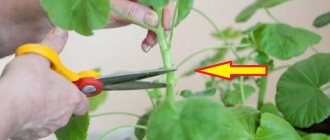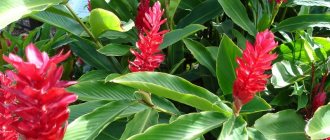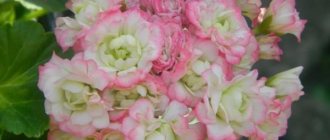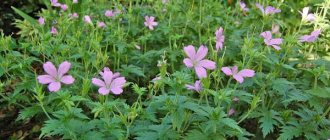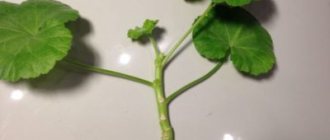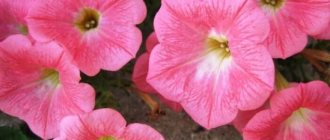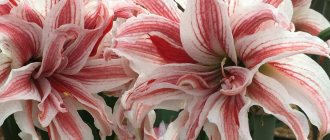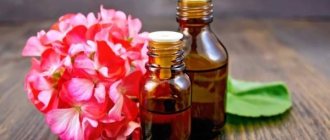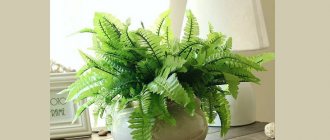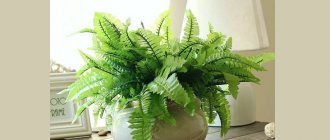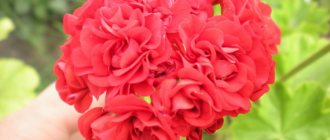The Geranium family, or Crane family, to which indoor geranium belongs, is widespread in the world. Everyone's favorite plant is pelargonium, which is native to southern Africa. There are more than 200 species of pelargonium. In recent years, hybrid garden forms have appeared, combining a variety of colors and different sizes of flowers, while their shape is traditional. Garden geranium at home allows you to create an interior in a country or romantic style. The flower acts as a solo element and attracts attention. It’s worth figuring out where it’s best to keep it and what signs are associated with this plant.
What does geranium look like?
The Latin name for geranium is pelargonium. Many people know this plant by this name. In general, the name of the flower comes from the Greek word “pelargos”, which means “stork”. Geranium fruits really look like a stork's beak.
Despite the fact that geranium is called pelargonium, they are still different flowers, although they belong to the same family. What is the difference between geranium and pelargonium?
Pelargonium flowers differ in shape. They form large umbrella-inflorescences. There are many varieties of this plant: there are white, pink and dark red flowers. There are also two-color varieties.
Geranium flowers consist of 5-7 symmetrical petals. They are often solitary or form semi-umbrella inflorescences. There are flowers with purple and blue inflorescences. White, crimson, and pink plant varieties are popular among gardeners.
Depending on the variety, the appearance of geranium may vary. Zonal geranium has dark green leaves with brown edges, ivy-leaf flowers resemble the shape of ivy, and Angel geranium resembles a pansy.
History of geranium cultivation and folk signs
Pelargonium was brought to Europe from South Africa. Thanks to the work of breeders, many cultivated varieties have appeared that are easy to care for and beautiful in appearance. Today, pelargonium is quite popular as an element of interior decor for various cafes, shops and other establishments, because it has a long flowering period.
There are many shades of geranium and there is a belief that, depending on the color, the little ball can have different effects on the aura of the home and family:
- red - gives vitality, saves from fatigue and fights laziness;
- pink - helps to attract a soul mate and keeps the hearth at home;
- the purple flower directs towards enriching the inner world and developing spirituality;
- white - symbolizes fertility, it is good to give as a wedding gift.
Interesting!
Folk signs also say that geranium protects the house from evil spirits and gives positive energy to all residents of the house in which it grows, this helps to avoid quarrels and scandals.
Medicinal properties of geranium
Steppe geranium has the following effects on the body:
- It has a blood purifying effect, so it can be used to treat gout.
- Relieves inflammation of the mucous membranes of the nose and mouth.
- Has antiviral and antibacterial effects.
- Relieves swelling.
- Is an active antioxidant.
- A decoction of geranium is effective for diabetes, diarrhea, kidney and liver diseases.
- An infusion from the plant can dissolve kidney stones.
- Removes toxins, nucleins and other harmful substances due to a large amount of tannins.
- Some healers use the plant to treat oncology.
- Flowers and leaves have an astringent, tonic, anthelmintic effect.
The healing properties of homemade geranium
Geranium or pelargonium - the one that grows in the house, has similar properties as its steppe relative:
- increases the body's defenses in the fight against acute respiratory viral infections;
- copes with headaches;
- normalizes blood pressure;
- promotes the dissolution of kidney stones;
- copes with depression, decreased mental activity;
- relieves skin problems: burns, frostbite, dermatitis, eczema, etc.
Geranium at home - where is it better to place it in an apartment, in a flowerpot or on a windowsill
The Geranium family, or Crane family, to which indoor geranium belongs, is widespread in the world. Everyone's favorite plant is pelargonium, which is native to southern Africa. There are more than 200 species of pelargonium. In recent years, hybrid garden forms have appeared, combining a variety of colors and different sizes of flowers, while their shape is traditional. Garden geranium at home allows you to create an interior in a country or romantic style. The flower acts as a solo element and attracts attention. It’s worth figuring out where it’s best to keep it and what signs are associated with this plant.
Dosage forms
Various dosage forms can be prepared from the aromatic plant:
- Essential oil. You can buy ready-made oil at the pharmacy, but you can prepare it yourself.
- Decoction. The crushed leaves and/or roots of the plant are poured with boiling water, the broth is filtered and cooled. The prepared medicine can be taken orally for diarrhea, osteochondrosis, rheumatism, used for gargling and hair, douched for uterine bleeding or female gynecological problems.
- Infusion - dry raw materials are infused in boiled water for at least 8 hours. The resulting infusion should be taken orally to normalize the functioning of the digestive tract, nervous system, etc.
- Freshly squeezed juice - just chop the leaves and stems and squeeze through cheesecloth.
- Dry powder - you can sprinkle it on sores and wounds. This product dries the skin, disinfects the wound, and helps it heal faster.
- Compresses - mash fresh leaves so that they release juice, apply to painful places and wounds.
- Ice cubes – used for facial skin problems.
- Geranium pillow – stuff the pillow with dried stems and flowers. Place it near the bed. This pillow soothes and relaxes, gives you a good night's sleep.
Geranium in cosmetology
Essential oil is made from geranium, which has a powerful effect on the skin, providing it with beauty and youth:
- the combination of geranium and clove essential oil helps cope with acne;
- a tandem of geranium oil and patchouli or chamomile moisturizes and smoothes the skin;
- restores skin tone, smoothes out shallow wrinkles, restores the firmness and elasticity of the dermis;
- normalizes the functioning of the sweat and sebaceous glands;
- strengthens hair, removes dandruff, soothes the scalp, activates hair growth;
- improves the functioning of the gastrointestinal tract;
- treats back problems;
- normalizes heart function;
- the juice of the plant helps to cope with a runny nose;
- Geranium infusion can cure a sore throat.
Geranium oil can be used for taking an aroma bath (add 5 drops of oil to a full bath), for rubbing (5 drops per 10 ml of base oil), and anti-cellulite massage (7 drops per 30 ml of base oil).
How to make butter at home?
The essential oil of the fragrant flower is industrially obtained by steam distillation. Typically, oil is extracted from several varieties of pelargonium. Ultimately, the consistency of the product should be viscous, oily, yellow or greenish in color with a tart aroma.
To avoid overpaying, you can make your own butter at home using the following recipes:
- Recipe 1: collect 1 kg of leaves and flowers of the plant, wash them, dry them naturally, chop them. Place the raw material in a glass jar, add water, and close with a nylon lid. Make a hole in the lid, insert a tube there, secure it with plasticine so that it does not fall inside the jar.
Place the outer end of the tube into a small dark bottle. This bottle should be placed in a glass with ice. Close the jar with a lid and tube and place in a water bath. When the contents of the jar begin to heat up, drops of essential oil will begin to appear in the bottle.
- Recipe 2: chop the flowers and leaves of a houseplant (200 g), add a glass of alcohol/vodka. Close the container with a lid and place in a bright place. After 2 weeks, add 50 ml of any oil you wish (olive, almond, etc.). Leave for another 14 days.
Where to put the flower
After weighing all the pros and cons, it is determined whether geranium is needed and whether the plant can be kept in the house. If you want to decorate your interior with brightly blooming pelargonium, you need to think about where it will be most comfortable.
In order for the plant to have a positive effect on home energy, calm the nerves and create a joyful mood, the choice of place for an indoor flower is approached from the perspective of Feng Shui. Science recommends placing pots of geraniums on a windowsill oriented to the southeast.
Experienced flower growers believe that pelargonium is unpretentious in choosing a place, so it can be placed in any room, regardless of the location of the windows. But frequent relocation of color negatively affects his “mood.”
Note! If the plant begins to smell sharply after moving, it is better to leave it in its original place.
In a private house, pelargonium is planted in a flower bed in the summer. Following Eastern teachings, the best place for geraniums will be flowerpots installed on both sides of the front door. This will help protect the house from bad energy. It is desirable that these are flowers with red petals. They are visible from afar and, according to legend, scare away ogling people.
The plant is in its place
If we take into account the functionality of the premises, then geraniums will be in place everywhere:
If there are windows in the bathroom and hallway, then pelargonium would be appropriate here too. By placing geraniums around the house, you don’t have to worry that your family will be bothered by flies, mosquitoes and other harmful insects.
Note! People who are sensitive to odors, but do not want to part with pelargonium, should not keep the flower in the rooms where they relax and work.
Geranium in a flowerpot
There are people who like to grow indoor flowers in a suspended state. Pelargonium can also be planted in flower pots. For this option, only certain varieties from the group of climbing (climbing) plants are suitable.
Pelargonium in a flower pot
Geraniums are hung low in a flowerpot and placed as close to sunlight as possible, choosing an eastern window for the summer and moving it to the south for the winter.
Geranium under artificial light
Not every apartment has windows facing the right direction. If the housewife is forced to keep pelargonium on the northern windowsill, the plant will not have enough sunlight. Therefore, additional illumination with a phytolamp or a fluorescent device will be required.
Chemical composition of geranium
The fragrant indoor flower has a number of useful properties due to its rich composition, which includes:
- glucose – improves brain function, relieves causeless anxiety, fear, depression;
- fructose – tones, relieves fatigue, prevents the development of caries;
- flavonoids – have an antibacterial effect, normalize blood pressure;
- catechins – protect the body at the cellular level, have an antioxidant effect;
- saponins - have a diuretic, tonic, anti-inflammatory effect;
- tannins – have an aseptic, astringent, hemostatic effect;
- carotene – cleanses the body of harmful substances, accelerates the process of cell regeneration, prevents the appearance of malignant tumors;
- vitamin C – slows down the aging process of the body, increases immune defense;
- vitamin K – improves the blood clotting process;
- alkaloids – have a sedative effect, have a positive effect on the cardiovascular system, and have an antimicrobial effect;
- anthocyanins – serve as powerful antioxidants, slow down the aging process of the skin, treat neurological diseases;
- manganese – regulates metabolic processes, reduces cholesterol and fat deposits;
- copper – participates in the production of collagen, normalizes the functioning of the digestive tract.
Home first aid kit: recipes
Indoor geranium has found its use in the treatment of various ailments.
For insomnia and epilepsy
Make a decoction: 1 tbsp. l. crushed leaves and flowers, pour 0.5 liters of boiling water. Leave for 12 hours. Take 1 tbsp. l. every 3 hours.
For constipation
2 tsp. dry raw materials, pour boiled cooled water (0.5 l). Leave for at least 8 hours. Drink in small portions throughout the day.
For toothache
Rinse a fresh geranium leaf and place it behind the cheek on the side of the painful tooth for 20 minutes. Repeat the manipulation as pain appears.
For nasal congestion, runny nose
Place the leaves of the plant in cheesecloth, beat lightly with a hammer, and squeeze out the juice. Place 2 drops of juice into each nostril up to 3 times a day.
With high blood pressure
Bandage a fresh leaf of the plant to the pulse on both wrists.
For neuralgia
Apply the sheet to the sore spot, put linen cloth on top, and bandage it with a warm scarf. Change leaves 3-4 times during the day.
For otitis media
Fold a geranium leaf into a tube and insert it into the sore ear.
For eczema
Dip freshly picked pelargonium leaves into water and boil for 5 minutes over low heat. Make lotions from the warm broth.
For headaches, bad mood
It is enough to inhale the aroma of flowers. To do this, you can touch the leaves or rub one leaf in your palm.
For sleep problems
Place a pot with a plant in the vacationer’s bedroom.
For abdominal pain
Finely chop the geranium leaves, pour boiling water, leave for 5 minutes in a steam bath. Take the decoction up to 4 times a day.
For painful menstruation, heavy bleeding
Take 20 drops of freshly squeezed plant juice. Frequency of application – every 2 hours until symptoms completely stop.
For problems with the gastrointestinal tract
Pour crushed dry leaves and roots of the plant (2 tsp) into 0.5 liters of cold water. Leave for 8 hours. Strain, drink 150 ml up to 4 times a day.
For hemorrhoids
Mash a clean geranium leaf (you can use a mortar) and apply it to the hemorrhoidal bump (for external hemorrhoids).
For any bleeding
Pass fresh leaves and stems of the plant through a meat grinder. Squeeze out the mass. Use the resulting juice for nasal, uterine and other bleeding, making lotions from the juice.
For hair problems
Apply geranium oil to your fingertips and rub the product into your scalp. Wrap your head in a plastic bag and wrap it in a towel. Leave for half an hour, then rinse with warm water and wash your hair with shampoo.
For radiculitis and osteochondrosis
Cut off a dozen leaves of the plant, rinse, and knead in your hands until the juice releases. Apply the leaves to the painful area, cover with plastic, and secure with a warm scarf. Apply the compress before going to bed.
For acne
Grind 3 leaves to a paste. Add sour cream (1 tbsp), stir. Apply the mask to your face and rub in with your fingers. After 15 minutes, rinse with warm water. Frequency of application – 1 time per day.
Anti-aging
Pass the leaves of the plant through a meat grinder. Squeeze out the juice using cheesecloth. Add water in a 1:1 ratio. Pour geranium water into molds and freeze. Rub your face with ice cubes every day.
With regular use of such cubes, the number of wrinkles will significantly decrease, skin elasticity will increase, and a rejuvenating effect will be visible.
For hair loss
Pour boiling water (0.5 l) over dry raw materials (3 tbsp). Cool, strain. Rinse your hair with infusion. No need to rinse off.
What ailments and diseases does pelargonium treat?
Geranium is one of the most useful indoor plants. Our ancestors, through trial and error, found out what geranium heals, what are the optimal proportions for preparing infusions, decoctions and tinctures. Knowledge about the properties of geranium leaves, their use for household and therapeutic purposes was passed on from the older generation to the younger.
Effect on the body
Our ancestors knew about the healing properties of the plant, so they planted pelargonium in gardens and grew it in the window at home. Even the presence of a flower in the room had a beneficial effect, because... the plant saturated the air with phytoncides and had an aromatherapy effect.
Compresses, infusions, lotions and decoctions of pelargonium have antiseptic and anti-inflammatory, antiviral and analgesic, hemostatic and diuretic effects. They help with many diseases, ranging from skin diseases, colds and ending with heart problems and blood pressure.
Medicinal properties
Preparations based on geranium relieve pain, inflammation, and swelling. Pelargonium is an excellent antidepressant, normalizes the psychological state, fights sleep disorders, improves performance, and helps with many health problems.
An infusion of the leaves of the plant helps with influenza, ARVI, sore throats, runny nose and cough. Applying the leaf treats otitis media and soothes toothache. Compresses are prepared from crushed leaves for the treatment of radiculitis and osteochondrosis, and the hemostatic effect of the drug is used to stop nasal, pulmonary, and uterine bleeding.
In addition, geranium:
- normalizes the rhythm and functioning of the heart muscle, improves blood supply;
- has a positive effect on diseases of the gallbladder, liver, digestive and genitourinary systems.
What are the benefits of geranium oil?
Golden geranium oil, reminiscent of sunflower oil, exudes a viscous, fragrant odor. The ancient Greeks, Egyptians and Romans used it for inflammatory processes in the spine and premenstrual migraines.
Pelargonium ether, having an antiseptic effect, heals eczema, dermatitis, burns, herpes, and relieves inflammation. It is a proven remedy for the treatment of diseases of the ear, throat, oral mucosa, varicose veins and hemorrhoids; effective for heart diseases.
Aromatherapists advise using pelargonium essential oil to improve the quality of sleep, for irritability, fatigue, and depression. Geranium aroma is useful for headaches, migraines, inflammation of the gallbladder, diseases of the liver, gastrointestinal tract, hypertension, neurasthenia.
Contraindications. Limitations in use
An indoor flower not only helps to cope with various diseases, but can also cause harm:
- The plant or essential oil is non-toxic and non-irritating, but some people may experience an allergic reaction. In this case, you should stop taking the medicinal plant.
- When treating any diseases with geranium, it is important to take a break - 3 weeks of intensive treatment and 10 days of break.
- It is forbidden to take geranium decoction or oil orally on an empty stomach.
- You should not use geranium medicine before bed, as the plant can invigorate.
- Geranium should not be used on pregnant women or children under 6 years of age.
- Individual intolerance is another sign to stop taking the medicinal plant.
- It is forbidden for people suffering from asthma to be treated with geranium.
- It is not recommended to use the plant in any of its forms for chronic gastrointestinal diseases.
- Geranium juice should not be used for thrombosis - it thickens the blood and can aggravate the patient’s condition.
Fragrant, beautiful geranium, decorating the windowsills of many homes, is a real home medicine cabinet. After all, from the leaves, roots and flowers of the plant you can prepare decoctions, infusions and lotions that help cope with pain of various origins and gastrointestinal diseases.
But you should not use this plant thoughtlessly, because in addition to benefits, it can also cause harm. Therefore, before making essential oil or other medicinal form from this flower, you need to undergo a sensitivity test to check for allergic reactions.
Harm of geranium to humans and contraindications
Due to the specific chemical composition, geranium can sometimes cause harm to human health. The most common problem associated with this flower is an allergic reaction to it. If it occurs, symptoms may include headache, cough, nasal congestion, and swelling of the mucous membrane. If such a reaction to pelargonium occurs, you will have to get rid of the plant, since individual intolerance, although a rare phenomenon, there is no cure for it.
Medicines based on geranium are contraindicated in a number of cases:
- chronic gastrointestinal diseases;
- exacerbation of ulcers, gastritis;
- thrombophlebitis;
- high level of blood viscosity.
Pregnant and lactating women, young children and older people should also limit the ingestion of any medications containing pelargonium oil or any of its components. For these groups, it is permissible to use the plant externally when such a need arises.
